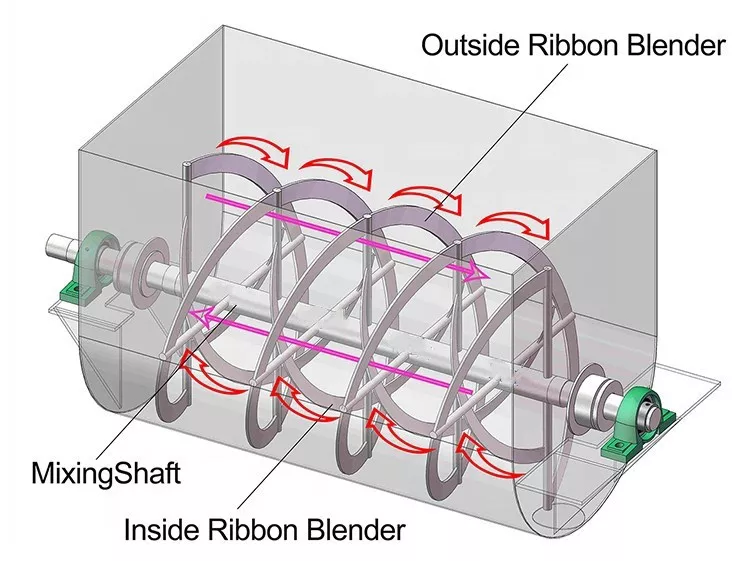
Karvil Machinery Ribbon Mixer
Horizontal ribbon mixer is used for powder and powder mixing, powder with a small amount of liquid mixing. Its design typically consists of a U-
shaped horizontal trough and an agitating assembly composed of inner and outer helical ribbons that rotate on a central shaft. These ribbon blades move materials in opposing directions, creating a mixing action. Additionally, ribbon blenders can often be customized with various features, such as jackets, spray settings, hoppers, feeders, and discharge valves which can suit specific blending requirements. Ribbon mixers are commonly used for for food, building, chemical, agricultural and other industries, such as food powder, dry mortar powder, fertilizer, seeds, spices, coffee powder other granular materials.
Customization Options

- The mixer can be made with all stainless steel or materials contact part with stainless steel or all carbon steel.
- Interior Surfaces: Mirror polished.
- Discharge: Manual valve or pneumatic valve.
- Safety device:Safety grid on the cylinder. Emergency stop device when the lid is open while the safety grip is not on the cylinder
- Heating function ( optional): Electric heating with jacket for heating transfer oil; Jacket for steam; Jacket for water circulation.
- Cooling function( optional): Jacket for cooling water circulation or equipped together with a chiller.
- Vacuum function( optional): it includes vacuum pump, metal hose, buffer tank and vacuum gauge. Vacuum degree can reach-0.096mpa.
- Other customized function can be discussed.
Working Principle
Cylinder structure: The main part of the horizontal ribbon mixer is a cylindrical tank, usually made of stainless steel or carbon steel. The inside of the tank is usually smooth and flat to allow free flow of material and easy cleaning.
Ribbon structure: Inside the cylinder, there is a spiral mixed ribbon. This double helix spiral usually rotates around an axis. The axial speed of the ribbon is usually relatively fast to effectively stir and mix the materials.
The ribbon blender is the double spiral. The outer spiral belt pushes inward and the inner spiral belt pushes outward so that the materials form convection & tumble motion to insure thorough mixing homogeneity in short cycle times to achieve the purpose of fast and uniform stirring. When discharging the materials, the outer ribbons move the materials toward the center discharge valve.

Technical Parameters
| Spec | WLDH-100 | WLDH-300 | WLDH-500 | WLDH-1000 | WLDH-1500 | WLDH-2000 | WLDH-3000 | WLDH-4000 | WLDH-6000 | WLDH-8000 | WLDH-10000 |
| Total volume(L) | 100 | 300 | 500 | 1000 | 1500 | 2000 | 3000 | 4000 | 6000 | 8000 | 10000 |
| Mixed amount/batch (L) | 30-60 | 90-180 | 150-300 | 400-600 | 450-900 | 600-1200 | 900-1800 | 1200-2400 | 1800-3600 | 2400-4800 | 3000-6000 |
| Power (Kw) | 1.5-4 | 3-5.5 | 4-11 | 7.5-15 | 11-18.5 | 15-22 | 18.5-30 | 22-37 | 37-55 | 37-55 | 45-75 |
| Rotating speed (RPM) | 65 | 65 | 65 | 46 | 38 | 33 | 28 | 28 | 28 | 24 | 21 |
Advantages of Ribbon Mixer
1. Ribbon Agitators: Ribbon mixers feature a set of inner and outer helical agitators (ribbons) that rotate in opposite directions. These agitators effectively move materials in both radial and axial directions, ensuring thorough mixing.
2. Versatility: Ribbon mixers are versatile and can handle a wide range of materials, including powders, granules, pastes, and cohesive materials. They are commonly used in industries such as food processing, pharmaceuticals, chemicals, and construction.
3. Uniform Mixing: Ribbon mixers provide excellent mixing uniformity, ensuring consistent product quality. The design of the agitators promotes efficient material movement and distribution throughout the mixing chamber.
4. Easy to Clean: Many ribbon mixers feature a design that allows for easy access to the mixing chamber, facilitating quick and thorough cleaning between batches. This is especially important in industries with stringent hygiene standards, such as food and pharmaceuticals.
5. Various Configurations and Sizes: Ribbon mixers are available in various configurations and sizes to suit different production requirements. They can be horizontal or vertical, batch or continuous, and can vary in capacity from small laboratory-scale units to large industrial-scale machines.
6. Optional Features: Depending on the specific application, ribbon mixers may come with additional features such as heating or cooling jackets for temperature control, vacuum or pressure capabilities for specific processing requirements, and automated controls for precise operation.
Applications
1. Food Industry:
Mixing dry ingredients such as flour, sugar, salt, spices, and powdered additives to produce bakery products, snack foods, confectioneries, and seasonings.
Blending ingredients for ready-to-eat meals, cereal mixes, nutritional supplements, and powdered beverages.
2. Pharmaceutical Industry:
Mixing powders, granules, and excipients for the production of pharmaceutical formulations such as tablets, capsules, and powders.
Mixing pharmaceutical powders with lubricants and disintegrants for tablet manufacturing.
3. Chemical Industry:
Blending dry chemicals, pigments, dyes, and additives for the production of paints, coatings, adhesives, and sealants.
Homogenizing powdered detergents, cleaners, and personal care products.
4. Animal Feed Industry:
Mixing various grains, cereals, proteins, vitamins, minerals, and additives to produce balanced animal feed formulations for livestock, poultry, and aquaculture.
5. Construction Industry:
Mixing dry building materials such as cement, lime, gypsum, sand, and aggregates to produce mortar, grout, plaster, and concrete.
Blending additives, colorants, and admixtures into cementitious mixes for customized construction applications.
Karvil Machinery Ribbon Mixer Videos
Karvil has a professional technical team dedicated to the research, design, and manufacturing of Sigma mixers and ribbon blenders. Our equipment has already been sold to over 50 countries and various industries worldwide.